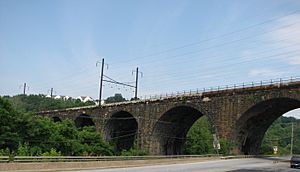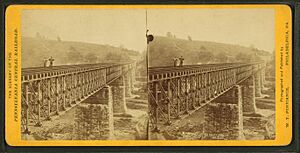High Bridge (Coatesville, Pennsylvania) facts for kids
Quick facts for kids High Bridge |
|
|---|---|

View of the bridge from the southeast side.
|
|
| Coordinates | 39°59′2″N 75°49′39″W / 39.98389°N 75.82750°W |
| Crosses | West Branch Brandywine Creek and Pennsylvania Route 82 |
| Locale | Chester, Pennsylvania, United States |
| Maintained by | Amtrak |
| Characteristics | |
| Total length | 934 ft (285 m) |
| Width | 52 ft (16 m) |
| Height | 78 ft (24 m) |
| History | |
| Constructed by | Pennsylvania Railroad |
| NRHP reference No. | 76001623 |
| Added to NRHP | March 26, 1976 |
| Lua error in Module:Location_map at line 420: attempt to index field 'wikibase' (a nil value). | |
The Coatesville High Bridge is a huge stone bridge for trains in Coatesville, Pennsylvania. It crosses the valley of the West Branch Brandywine Creek. The Pennsylvania Railroad built this amazing bridge between 1902 and 1904.
It has ten big arches, which are curved supports. Eight of these arches are about 78 feet (24 meters) wide, and two are about 88 feet (27 meters) wide. The bridge stretches for a total length of 934 feet (285 meters). If you include its side walls, it's even longer, at 1,287 feet (392 meters).
The bridge stands 78 feet (24 meters) high. It was designed to carry four train tracks side-by-side. The total width of the bridge is 52 feet (16 meters). This bridge is a key part of the Pennsylvania Railroad's main line. It helps trains cross the Brandywine Creek and also goes over Pennsylvania Route 82.
A Look Back: Earlier Bridges
The very first bridge at this spot was built way back in 1832. It was made of wood and had stone supports. This bridge was for a single train track. Later, in 1854, it was made wider to hold two tracks.
This wooden bridge was replaced in 1867 with a bridge made of cast iron. Then, in 1890, that iron bridge was replaced with a wrought iron bridge. By the early 1900s, even this two-track bridge wasn't big enough. It was causing a "bottleneck," meaning trains had to slow down because the main line on both sides had four tracks. So, plans were made for a brand new bridge that could carry all four tracks.
Building the Big Stone Bridge
Even though the Pennsylvania Railroad was using steel for many bridges, the president, A. J. Cassatt, chose to build this new bridge out of stone. This decision was influenced by the railroad's Chief Engineer, William H. Brown. He believed stone bridges were stronger and lasted longer.
Stone bridges also cost less to take care of over time, even if they were more expensive to build at first. Work on the Coatesville High Bridge started in November 1902. It was built a little south of the old two-track bridge.
The construction finished on September 1, 1904. Once it was done, the main train line was moved to cross the new stone bridge. This change also made the train tracks straighter in that area. It helped complete the Pennsylvania Railroad's four-track main line all the way from Philadelphia to the Conestoga River bridge near Lancaster.
The Bridge Today
Over the years, some updates were made to the bridge. A concrete wall was added along the top, and parts of the arches were made stronger with concrete. In the 1930s, tall poles were put on the bridge to hold the wires for electric trains.
The ownership of the bridge changed hands a few times. In 1968, it became part of Penn Central railroad. Then, in 1976, it was taken over by Amtrak, which still owns it today.


